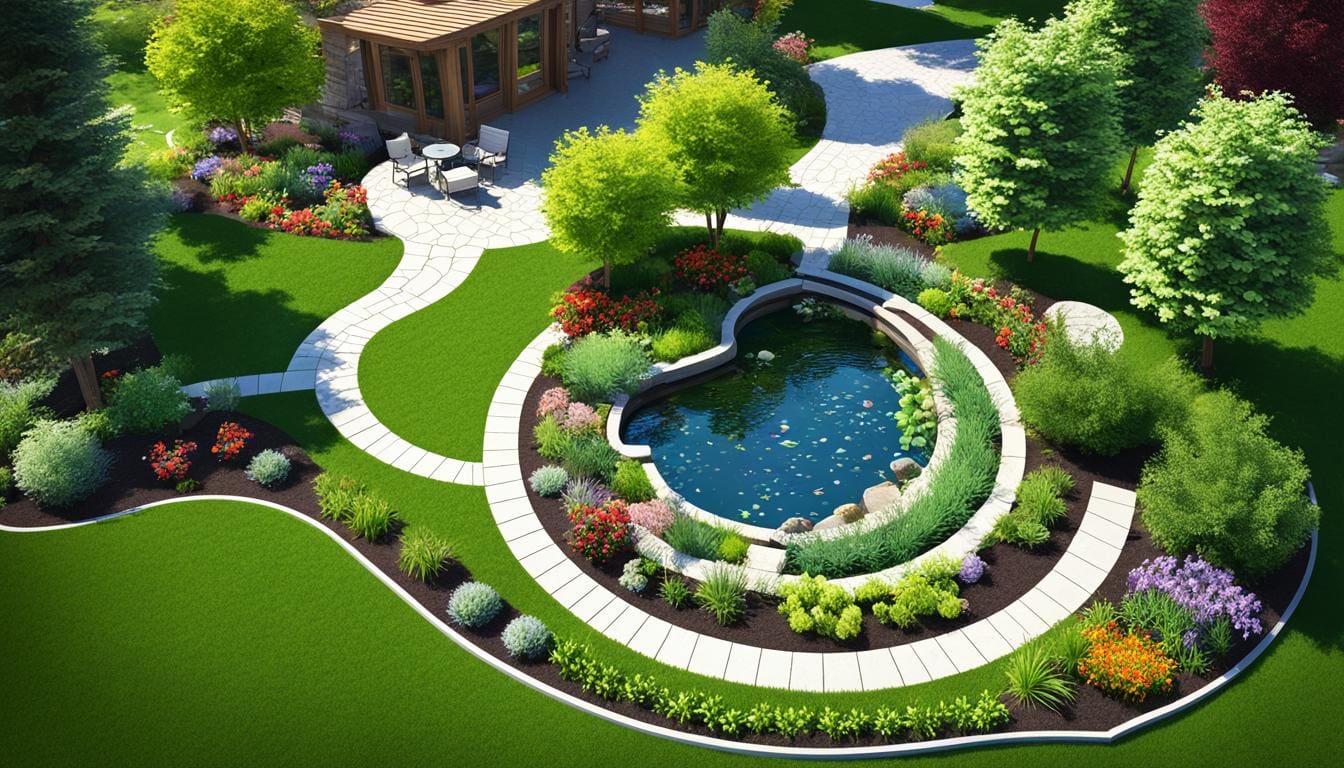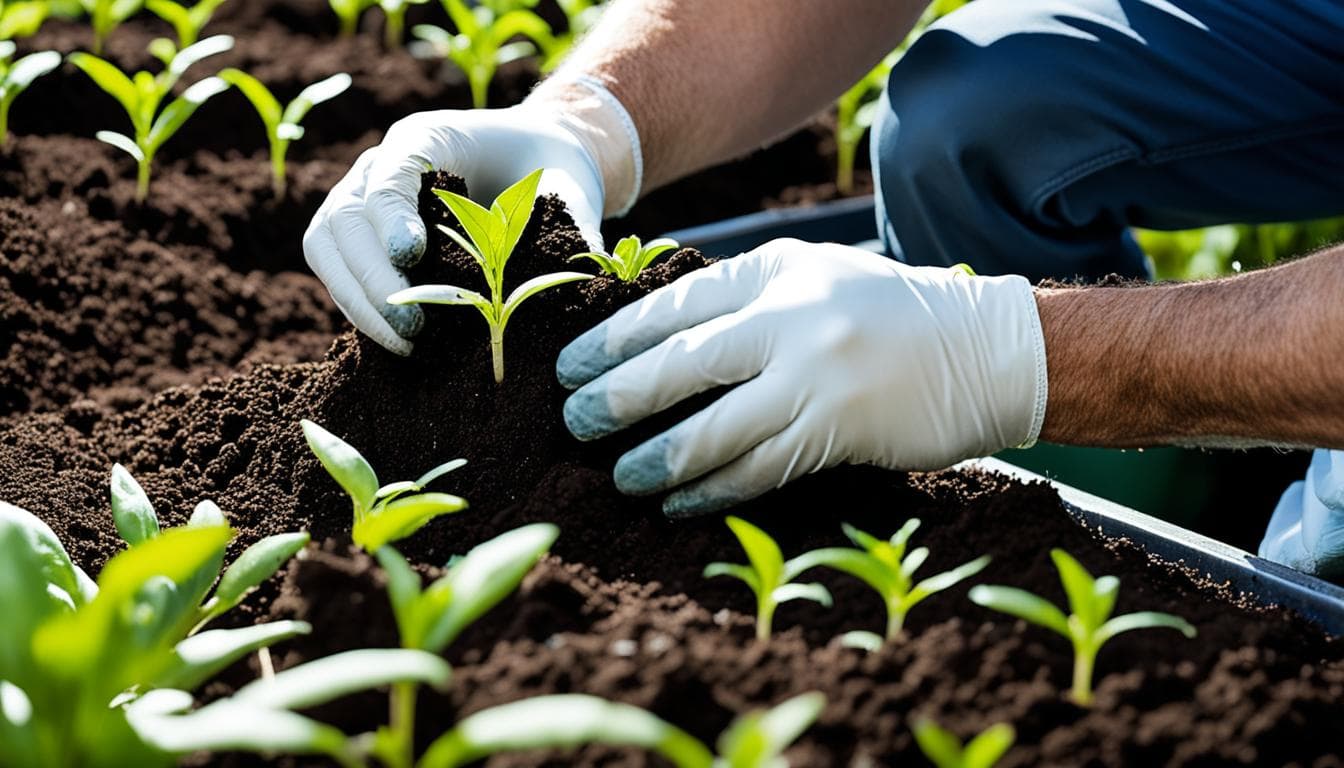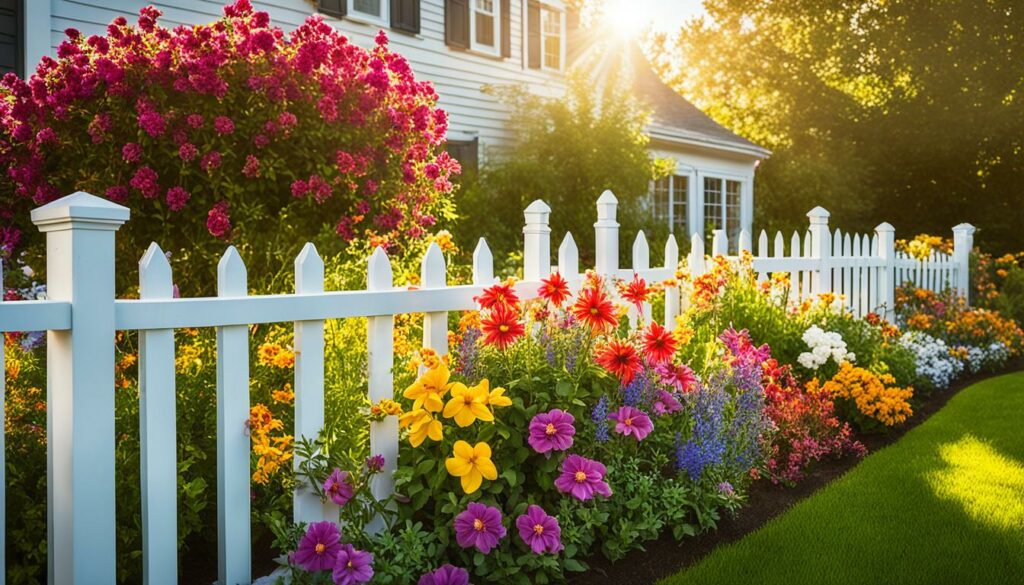Want a beautiful garden but not sure how to start? This guide is perfect for you. Landscaping may look hard at first, but it’s totally doable with the right advice. You can make your outdoor space look amazing, whether it’s a DIY project or basic care you need.
At its heart, landscaping creates places that look good and work well outdoors. This could be anything from big parks to small home gardens. The secret to good landscaping is making a plan. Use plants, trees, flowers, and things like water features and stones. For gardening, it’s more about planting, feeding, pulling out weeds, and picking from your own garden.
Picking the right plants to start is key. Look for ones that are easy to take care of and fit your area’s climate. This way, your garden will need less work. You can still make your yard a great place with some smart design and a few projects.
Key Takeaways
- Landscaping involves creating a plan for an outdoor area using various elements like plants, hardscapes, and water features.
- Gardening focuses on the hands-on work of planting, maintaining, and harvesting within a specific space.
- Choose beginner-friendly, low-maintenance plants well-suited to your climate when starting out.
- Simple landscape design ideas and easy DIY projects can transform your outdoor space on a budget.
- With the right tips and tricks, anyone can create a stunning garden or give their backyard a makeover.
Understanding the Basics of Landscaping and Gardening
Creating a beautiful outdoor area starts with knowing the basics of landscaping and gardening. Although people use these terms together, they’re different. Getting these basics down lets you make a garden that looks great. It will also make your home more attractive and help the planet.
Differences Between Landscaping and Gardening
Landscaping looks at the big picture and layout of your outdoor space. This includes grass, plants, trees, flowers, and even non-living items like water features or fences. It’s about making everything work well together outside, considering size, match, and use.
Gardening is working with the actual plants in a space. It’s about planting, caring for, and growing flowers, veggies, herbs, and shrubs. To garden well, you need to know about plant care, soil health, and growing methods.
Benefits of Landscaping and Gardening
Getting into landscaping and gardening can boost your physical and mental health. It’s also great for the planet. Here are some key upsides:
- Physical Benefits: It’s a form of exercise that’s good for your heart, muscles, and flexibility. Plus, being outside is healthy for you, giving you vitamin D and fresh air.
- Mental Health Benefits: It’s been proven to lower stress and improve your mood. It’s a creative, rewarding way to chill out with nature.
- Environmental Benefits: Going green in the garden saves water and cuts waste. Plus, gardens support lots of helpful bugs and animals, making your area more interesting.
- Home Value and Curb Appeal: A nice garden can make your home more valuable and stand out. It’s your house’s first hello.
| Aspect | Landscaping | Gardening |
|---|---|---|
| Focus | Overall design and layout of outdoor space | Caring for plants specifically |
| Scope | Big picture, with both living and non-living elements | Focuses only on the plants and how to keep them healthy |
| Skills | Design, planning, material picks | Planting know-how, growing methods |
Learning about landscaping and gardening lets you build a special outdoor place. It won’t just look good, it will also be good for you and the planet. Whether you’re just starting small or planning a whole garden, these basics are key to success.
Planning Your Landscape Design
To make your landscape both beautiful and useful, you need a good plan. Start by looking at your outdoor area. Think about what you want and draw a detailed plan. This will help make your yard a place that’s beautiful and suits your needs.
Assessing Your Outdoor Space
Before you start designing, look closely at your yard. Take note of driveways, walls, and trees. Measure your space and mark important things like utilities and sunny spots. This lets you really know your yard and helps plan better.

Creating a Wishlist and Setting Priorities
Now, make a list of what you want in your yard. Think about the goals for your design. You might want more privacy, a nicer look, or special outdoor areas. Rank your wishes based on budget and what your yard needs. This list will be your guide, keeping you on track.
Sketching Your Landscape Plan
Using your yard details and wishlist, it’s time to sketch. Think about plant combos and add hardscapes like paths or patios. Use your yard’s features well; for example, a dry spot can become a rock garden. Remember plant sizes as you draw. A good sketch makes your design clear and prevents problems later.
Choosing the Right Plants for Your Garden
Starting your garden means finding the right plants. Think about the weather, soil, and how much sun they’ll get. Picking plants that love your garden’s conditions means you’ll have a lively garden that lasts. For beginners interested in landscaping, incorporating artificial grass can be an easy and low-maintenance option to instantly enhance the aesthetic appeal of their outdoor spaces.
Considering Climate, Soil, and Sunlight
It’s key to know your local climate and space features before buying plants. Australia’s climates vary a lot, from tropical up north to temperate down south. Find plants that match your area’s temperature, rainfall, and humidity.
Australia also has many soil types, from beachy sand to dense clay. Test your soil to learn its pH and nutrients. This test helps you choose the best plants and improve your soil.
Don’t forget about sun. Notice which parts of your garden get full sun, some sun, or no sun. Pick plants that suit these areas. This ensures your plants will grow well.
Selecting Plants for Colour, Texture, and Height
After considering climate and sunlight, focus on how you want your plants to look. Mix colours, textures, and heights for a beautiful garden.
Colour can change your garden’s mood. Use a colour wheel to find matching or contrasting colours. Mix plant colours and flowers for a stunning look.
Textures make your garden more interesting. Combine soft and rough plants for a lively garden. This mix adds depth and movement.
Use plants of different heights for a balanced look. Place tall plants at the back and low ones in the front. This method uses your garden’s space well.
| Plant Height | Examples | Placement |
|---|---|---|
| Tall | Trees, shrubs, climbing vines | Background, privacy screens, focal points |
| Medium | Perennials, small shrubs, tall grasses | Middle layer, transitions between tall and low plants |
| Low | Groundcovers, small perennials, low grasses | Foreground, borders, edges of paths |
Incorporating Native and Low-Maintenance Plants
Consider using Australian native or low-maintenance plants. Natives are more likely to thrive and need less care. They also support local wildlife.
Low-maintenance plants are great for those new to gardening or with little time. They need less water, trimming, and fertiliser. Some options include plants that cope well with dryness, shade, or love the sun.
Mixing native and easy-care plants makes your garden better for the earth. And it’s less work for you.
“The best time to plant a tree was 20 years ago. The second best time is now.” – Chinese Proverb
Picking the right plants is crucial for a great garden. Think about your area’s climate and space, as well as how you want your garden to look. This care in selecting plants will help you grow a garden you’ll love for years.
Landscaping for Beginners: Essential Tools and Techniques
Starting out in landscaping and gardening, the right tools and skills are key. You need to invest in important gardening tools. It’s also essential to learn about soil prep, planting, watering, fertilizing, mulching, and garden upkeep. These steps are crucial for your landscaping journey.
Basic Gardening Tools Every Beginner Should Have
Beginners in landscaping and gardening need several basic tools. These include:
- Pruner: Useful for cutting dead plants and shaping them.
- Hand trowel: Great for digging and moving soil in small spaces.
- Sturdy rake: Useful for smoothing soil and cleaning your garden bed.
- Watering can: Vital for watering plants and applying liquid fertilizers.
Preparing Soil and Planting Techniques
Getting the soil ready is crucial for plant health. First, loosen the soil in your garden bed. Add some organic matter like compost. This improves the soil’s structure and nutrients. Use a rake to make the surface level for planting.
When planting, make sure to customize your method to the plant. For seedlings or small plants, make a hole for the root ball. Place the plant carefully in the hole. Cover with soil and gently press around the plant to secure it in the ground.

Watering, Fertilizing, and Mulching
Watering your plants well is vital, especially as they grow. Make sure to water deeply but adjust based on the plant’s needs. Use a watering can or a hose with a gentle spray to avoid damage.
Fertilizer gives plants the nutrients they need to grow. Pick the right type of fertilizer for your plants. Follow the directions on the package. Don’t use too much as it might harm your plants.
Mulch is essential for gardening too. Put a layer of organic mulch like bark chips around your plants. This helps stop weeds and keeps moisture in the soil. Over time, the mulch will also make your soil better.
Maintaining Your Landscape and Garden
To keep your garden looking great, regular maintenance is a must. This includes:
- Pruning: Trim dead bits off your plants to make them healthier and look better.
- Weeding: Get rid of weeds regularly so they don’t steal nutrients and water from your plants.
- Pest control: Keep an eye out for pests and deal with them using safe methods or get advice from experts.
- Cleaning: Remove old leaves, debris, and dead plants to keep your garden clean.
By doing these maintenance tasks regularly and sticking to a care schedule, your landscape and garden will stay healthy and beautiful.
Conclusion
Starting your first landscaping for beginners project might feel like a big task. But, with a good plan and the right info, you can make your garden beautiful. This beginner’s guide to gardening will give you the basics. You’ll learn about landscape design, picking the right plants, and looking after your garden.
Gardening is all about learning and growing. Take time to look at your space and plan what you want. Choosing the best plants for your garden is essential. As you do this, you’ll get better and start to love nature more. Don’t shy away from the tough parts. They are all part of the fun of gardening. Learning and trying new things make it even more rewarding.
With hard work and a love for learning, your garden will soon change. Use this article as your garden inspiration. It will help you make a stunning outdoor space. You will love spending time in your garden. Watching it get better each day will make you very happy. This is a project where you are the main creator. Enjoy it!
Source Link
https://www.thespruce.com/landscape-design-for-beginners-2130815
https://www.almanac.com/landscape-design-ideas-and-advice-beginners
https://todayshomeowner.com/lawn-garden/guides/landscaping-for-beginners/

